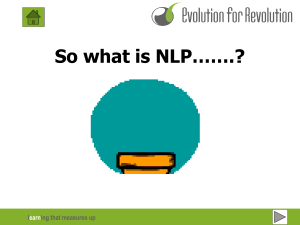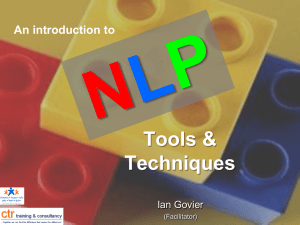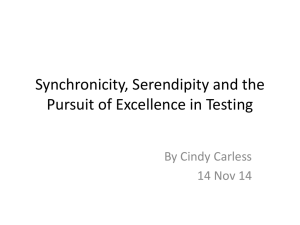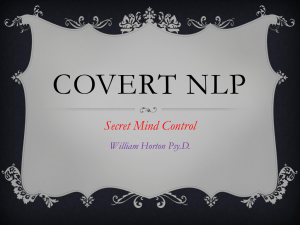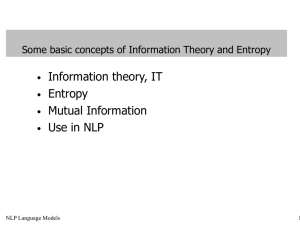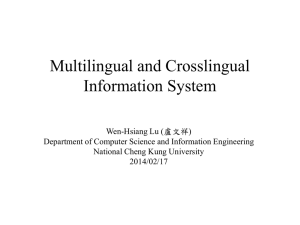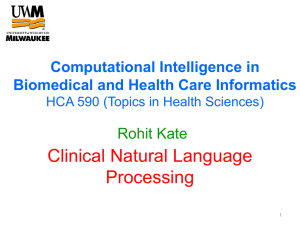NLP poster - Ecem GÖDE
advertisement
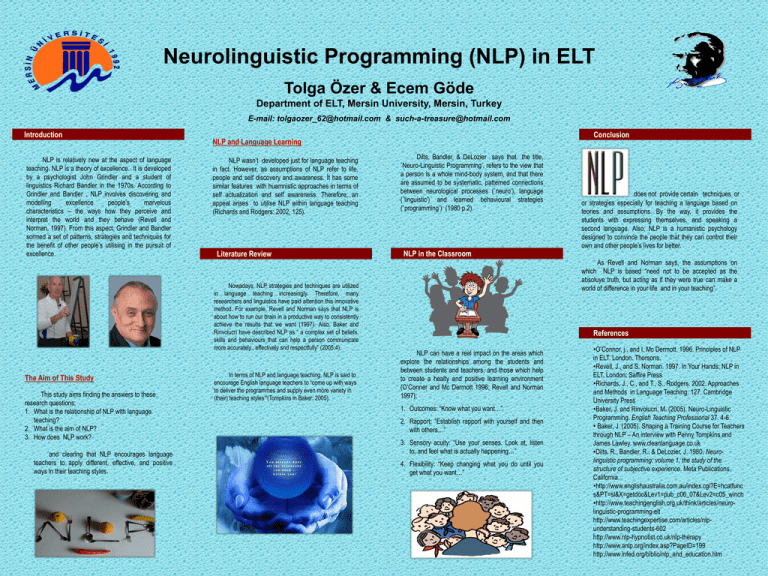
Neurolinguistic Programming (NLP) in ELT Tolga Özer & Ecem Göde Department of ELT, Mersin University, Mersin, Turkey E-mail: tolgaozer_62@hotmail.com & such-a-treasure@hotmail.com Introduction NLP is relatively new at the aspect of language teaching. NLP is a theory of excellence. It is developed by a psychologist John Grindler and a student of linguistics Richard Bandler in the 1970s. According to Grindler and Bandler , NLP involves discovering and modelling excellence people’s marvelous characteristics – the ways how they perceive and interpret the world and they behave (Revell and Norman, 1997). From this aspect, Grindler and Bandler sormed a set of patterns, strategies and techniques for the benefit of other people’s utilising in the pursuit of excellence. NLP and Language Learning NLP wasn’t developed just for language teaching in fact. However, as assumptions of NLP refer to life, people and self discovery and awareness. İt has some similar features with huamnistic approaches in terms of self actualization and self awareness. Therefore, an appeal arises to utilise NLP within language teaching (Richards and Rodgers: 2002, 125). Literature Review Nowadays, NLP strategies and techniques are utilized in language teaching increasingly. Therefore, many researchers and linguistics have paid attention this innovative method. For example, Revell and Norman says that NLP is about how to run our brain in a productive way to consistently achieve the results that we want (1997). Also, Baker and Rinvolucri have described NLP as “ a complex set of beliefs, skills and behaviours that can help a person communicate more accurately., effectively snd respectfully” (2005:4). The Aim of This Study This study aims finding the answers to these research questions; 1. What is the relationship of NLP with language teaching? 2. What is the aim of NLP? 3. How does NLP work? and clearing that NLP encourages language teachers to apply different, effective, and positive ways in their teaching styles. Conclusion In terms of NLP and language teaching, NLP is said to encourage English language teachers to “come up with ways to deliver the programmes and supply even more variety in (their) teaching styles’”(Tompkins in Baker: 2005). Dilts, Bandler, & DeLozier says that the title, `Neuro-Linguistic Programming’, refers to the view that a person is a whole mind-body system, and that there are assumed to be systematic, patterned connections between neurological processes (`neuro’), language (`linguistic') and learned behavioural strategies (`programming’) (1980 p.2). NLP in the Classroom does not provide certain techniques or or strategies especially for teaching a language based on teories and assumptions. By the way, it provides the students with expressing themselves, and speaking a second language. Also, NLP is a humanistic psychology designed to convince the people that they can control their own and other people’s lives for better. As Revell and Norman says, the assumptions on which NLP is based “need not to be accepted as the absoluye truth, but acting as if they were true can make a world of difference in your life and in your teaching”. References NLP can have a real impact on the areas which explore the relationships among the students and between students and teachers, and those which help to create a healty and positive learning environment (O’Conner and Mc Dermott 1996; Revell and Norman 1997): 1. Outcomes: “Know what you want…” 2. Rapport: “Establish rapport with yourself and then with others…” 3. Sensory acuity: “Use your senses. Look at, listen to, and feel what is actually happening…” 4. Flexibility: “Keep changing what you do until you get what you want…” •O’Connor, j., and I. Mc Dermott. 1996. Principles of NLP in ELT. London. Thorsons. •Revell, J., and S. Norman. 1997. In Your Hands; NLP in ELT. London: Saffire Press •Richards, J., C., and T., S., Rodgers. 2002. Approaches and Methods in Language Teaching. 127. Cambridge University Press •Baker, J. and Rinvolucri, M. (2005). Neuro-Linguistic Programming. English Teaching Professional 37. 4-6. • Baker, J. (2005). Shaping a Training Course for Teachers through NLP – An interview with Penny Tompkins and James Lawley. www.cleanlanguage.co.uk •Dilts, R., Bandler, R., & DeLozier, J. 1980, Neurolinguistic programming: volume 1, the study of the structure of subjective experience. Meta Publications, California. •http://www.englishaustralia.com.au/index.cgi?E=hcatfunc s&PT=sl&X=getdoc&Lev1=pub_c06_07&Lev2=c05_winch •http://www.teachingenglish.org.uk/think/articles/neurolinguistic-programming-elt http://www.teachingexpertise.com/articles/nlpunderstanding-students-602 http://www.nlp-hypnotist.co.uk/nlp-therapy http://www.anlp.org/index.asp?PageID=199 http://www.infed.org/biblio/nlp_and_education.htm

